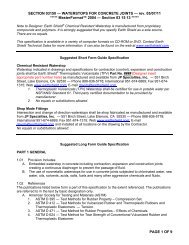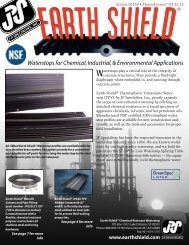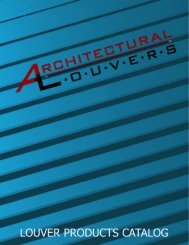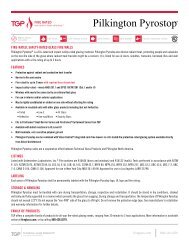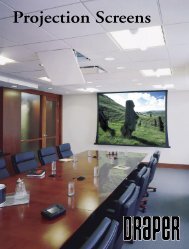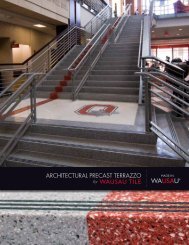National Gypsum Construction Guide
National Gypsum Construction Guide The entire - AECinfo.com
National Gypsum Construction Guide The entire - AECinfo.com
- No tags were found...
You also want an ePaper? Increase the reach of your titles
YUMPU automatically turns print PDFs into web optimized ePapers that Google loves.
EXTERIOR APPLICATIONS<br />
APPLICATIONS<br />
An ideal underlayment for<br />
exterior applications such as:<br />
Stucco applications<br />
Countertops<br />
Soffit panels<br />
Sheathing panels<br />
Decks<br />
Outdoor kitchens/grills<br />
INSTALLATION<br />
General: All framing should<br />
comply with local building<br />
code requirements and be<br />
designed to provide support<br />
with a maximum allowable<br />
deflection of L/360 under<br />
all intended live (including<br />
wind) and dead loads.<br />
Note: Cut or score<br />
PermaBase on rough side<br />
of panel. Install tile and<br />
tile setting materials in<br />
accordance with current<br />
ANSI specifications and<br />
Tile Council of America<br />
(TCA) guidelines.<br />
Control Joints: For exterior<br />
installations, allow a maximum<br />
of 16 lineal feet<br />
between control joints. A<br />
control joint must be<br />
installed but not limited to<br />
the following locations:<br />
where expansion joints<br />
occur in the framing or<br />
building (discontinue all<br />
cross furring members<br />
located behind joint);<br />
when boards abut<br />
dissimilar materials; where<br />
framing material changes;<br />
at changes of building<br />
shape or structural system;<br />
at each story separation.<br />
Place control joints at<br />
corners of window and<br />
door openings, or follow<br />
specifications of architect.<br />
Control joint cavity shall<br />
not be filled with coating<br />
or other materials.<br />
DECKS<br />
Subfloor: Plywood should be<br />
securely glued and fastened<br />
to floor joists spaced<br />
a maximum of 16" o.c.<br />
Subfloor should be sloped<br />
at a minimum pitch of 1/4"<br />
per foot. The floor surface<br />
should be true to plane<br />
within 1/8" in 10'.<br />
Underlayment: Using a 1/4"<br />
square-notched trowel,<br />
apply a setting bed of latex-<br />
Portland cement mortar to<br />
the subfloor. Immediately<br />
laminate PermaBase to subfloor,<br />
leaving a 1/8" space<br />
between boards at all joints<br />
and corners. Leave a 1/4"<br />
gap along walls. Stagger<br />
joints so they do not line up<br />
with underlying substrate<br />
joints. Fasten PermaBase<br />
every 8" o.c. throughout<br />
board field and around all<br />
edges while setting bed<br />
mortar is still workable.<br />
Around the perimeter of<br />
each board, locate fasteners<br />
2" from the corners and not<br />
less than 3/8" from the<br />
edges. Fill all joints solid<br />
with bonding material. On<br />
non-tapered joints such as<br />
butt ends, apply a 6" wide,<br />
1/16" thick coat over the<br />
entire joint. Embed alkali<br />
resistant fiberglass mesh tape<br />
fully into applied bonding<br />
material; ensure that tape is<br />
centered over joint. Apply<br />
bonding material over<br />
fasteners to fully conceal.<br />
Remove all excess bonding<br />
material and allow to cure.<br />
Waterproof Membrane:<br />
Trowel apply waterproof<br />
membrane to the entire<br />
surface of the PermaBase,<br />
following membrane<br />
manufacturer’s installation<br />
instructions in detail.<br />
WALLS & CEILINGS<br />
Wall Framing: Studs should be<br />
spaced a maximum of 16"<br />
o.c. Edges/ends of PermaBase<br />
parallel to<br />
framing should be continuously<br />
supported. Provide<br />
additional blocking when<br />
necessary to permit proper<br />
PermaBase attachment.<br />
Do not install PermaBase<br />
directly over protrusions<br />
from stud plane such as<br />
heavy brackets or fastener<br />
heads.<br />
Ceiling Framing: The deflection<br />
of the complete ceiling<br />
assembly due to dead load<br />
(including insulation,<br />
PermaBase, bonding material<br />
and facing material) should<br />
not exceed L/360. The dead<br />
load applied to the ceiling<br />
frame should not exceed 10<br />
psf. Ceiling joist or furring<br />
channel should not exceed<br />
16" o.c. (Edges of PermaBase<br />
parallel to framing should<br />
be continuously supported.)<br />
Provide additional blocking<br />
when necessary to<br />
permit proper PermaBase<br />
attachment.<br />
Weather Barrier: While<br />
PermaBase is unaffected by<br />
moisture, a water barrier<br />
must be installed to protect<br />
the cavity. It should be<br />
installed according to the<br />
manufacturer’s specifications.<br />
PermaBase Cement Board:<br />
Apply PermaBase with<br />
ends and edges closely<br />
butted but not forced<br />
together. Stagger ends<br />
joints in successive courses.<br />
Drive fasteners into field of<br />
cement board first, working<br />
toward ends and edges.<br />
Space fasteners maximum<br />
8" o.c. for walls, 6" o.c.<br />
for ceilings with perimeter<br />
fasteners at least 3/8" and<br />
less than 5/8" from ends<br />
and edges.<br />
Joint Reinforcement: Trowel<br />
bonding material to completely<br />
fill the tapered<br />
recessed board joints and<br />
gaps between each panel.<br />
On non-tapered joints<br />
apply a 6" wide, approx.<br />
1/16" thick coat of bonding<br />
material over entire joint.<br />
Immediately embed 4"<br />
alkali resistant fiberglass<br />
mesh tape fully into<br />
applied bonding material<br />
and allow to cure. Same<br />
bonding material should<br />
be applied to corners,<br />
control joints, trims or<br />
other accessories. Feather<br />
bonding material over<br />
fasteners to fully conceal.<br />
148<br />
PERMABASE BRAND CEMENT BOARD



